January 7th, 2020 Nerd Nite SD #36
This January, we brought back one of our voted number one speakers and Top Gun hero,
Paul Wynns, who told us “how to be a Top Gun: WITH MATH”. An SDSU graduate and soon-to-be licensed dietician,
Danielle Gaffen brought prunes to the table (literally) and explained how they could protect your bones (especially if you’re an older male).
Brittany Lee had something to say about protection (but mainly of your hearing)!
Paul Wynns: How to be a Top Gun: WITH MATH
Remember the movie Top Gun? Well, as it turns out, “Top Gun” is a real military organization with real pilots that do more than topless volleyball matches, motorcycle racing, and sunglass modeling. We’ll look at the history of Top Gun and air combat from the dawn of aviation. In the beginning, there were fighter pilots, and they were very dashing. Their first recorded encounters involved waving, shaking of firsts, throwing bricks, pistol fire, and grappling hooks. Since then, air combat has been a case study in “well that escalated quickly…” What’s the secret to success for fighter pilots through the ages? Put your shirt back on and leave the volleyball in your locker. We’re going to talk about the fundamentals of air combat maneuvering, which is all about geometry and physics. THERE WILL BE MATH.
Paul’s Bio
Paul is an avid fan of all things anime, manga, sci-fi, and fantasy, with minors in tabletop gaming and giant robots that transform into aircraft. He is an amateur flow artist and has performed with fire staff and sword at festivals in the Southern California region. He’s also trained in the martial arts of wushu and jissen kobudō.
Paul’s educational and professional background includes a postgraduate degree at Stanford University and an internship at the NASA Ames Research Center in Silicon Valley where he specialized in aerospace engineering and air vehicle design. He is a US Naval Academy graduate and retired Naval Aviator with 398 carrier landings that, to his knowledge, did not permanently injure any personnel or damage any government equipment. Previously, he’s worked at Boeing Defense, Space, and Security as an aircraft systems program manager, where he and his project team were awarded patents for developing new prototypes and concepts. He’s currently enrolled in an MBA program at the UCSD Rady School of Management. The main take-away from this bio is that Paul does not know what he wants to do when he grows up, and possibly has not grown up at all.
Paul currently runs an aviation training startup, Flex Air (www.goflexair.com) and the Kevin Workman Foundation (www.kevinworkmanfoundation.org), a local non-profit that brings art education to the nerds of tomorrow.
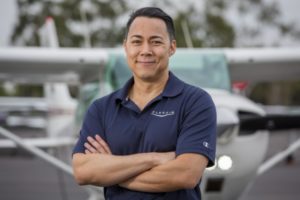
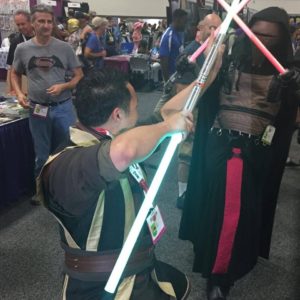
Danielle Gaffen: Prunes: More Than Just a Laxative
Did you know that osteopenia and osteoporosis affect over 54 million people in the United States and their incidences are increasing due to the aging of the population? Osteoporosis in men is an overlooked yet increasingly important clinical problem that, historically, has not received the same degree of awareness as with women. However, the lifetime risk of fracture is 20% for all men. Current osteoporosis prescription medications have low efficacy, high side effects, are very expensive, and are not indicated for bone loss prevention. Dried plums are natural foods that may be effective in preventing bone loss.
Learn more about the first nutritional intervention research study exploring the bone metabolism effects of dried plum consumption in older men.
Danielle’s bio
Danielle will graduate in December with a Master of Science degree in Nutritional Sciences from San Diego State University in order to become a registered dietitian. Danielle was head researcher of a nutritional intervention study premised upon the hypothesis that consuming dried plums may prevent bone loss in older men. Danielle’s preliminary research findings were published in the Current Developments in Nutrition journal and presented at the American Society for Nutrition conference in Baltimore earlier this year. Danielle will be submitting her full manuscript for publication within the next few months.
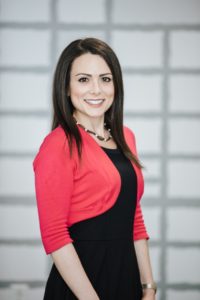
Brittany Lee F*** That Noise
Listen up, nerds! Have you ever experienced ringing in your ears? Join Brittany Lee for a night of ears and beers to find out what causes this sensation. Learn about hearing science, see if you’re at risk for noise-induced hearing loss, and get some sound advice for protecting your ears.
Brittany’s bio
Brittany is a Ph.D. candidate studying Speech, Language, and Hearing Sciences at San Diego State University and University of California, San Diego. She uses eye tracking and event-related potentials to research language co-activation and word processing in deaf and hearing readers. Outside of the lab, she spends most of her time at the speech-language clinic, in the kitchen, or on the dance floor.
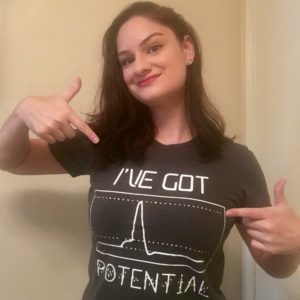
We Don’t Need No Water
Rounding out the safety trilogy after his popular “That Shit is Dangerous!” and “That’s Not a Fucking Tourniquet!” talks, workplace safety and emergency response expert Carlo E. returned to teach us all about fire extinguishers.
He explained the different types of fire extinguishers, and how different chemical extinguishing agents are used for different types of fires. We learned the nuances of amateur firefighting, and leave with some practical tips on what to do if everything around you is on fire.
Carlo has a master’s degree in public policy, and received a departmental best thesis award for his analysis of workplace safety regulation enforcement. He is credentialed as a Certified Safety Professional (CSP), Emergency Medical Technician (EMT), and Wilderness EMT, and has experience in incipient stage firefighting from starting lots of fires when he was younger.
—
Up in Arms: the art and style of sword fighting in full armor
If you’ve ever wondered what it would be like to be an armored hero from an epic tale like Game Of Thrones or The Lord Of The Rings, Scott Farrell and Loreen Mattis will give you an inside look at the life of a knight in shining armor. Their talk will provide insight into the design and function of historical armor, and how the (nearly lost) skills of the armor maker continue to be put to use in surprising ways in modern technology, from military ballistic protection to (no kidding!) equipment for keeping astronauts safe during the Apollo missions. Learn all about how to buy, strap on, and fight in medieval armor in the 21st century.
Scott Farrell is director of the Chivalry Today Educational Program, and lead instructor of the Swords of Chivalry Western Martial Arts training program. He (along with his tireless assistants Loreen Mattis and April Apperson) teaches five sessions of historical fencing each week at San Diego’s Team Touche Fencing Center, and Lionheart Fencing Academy. When he doesn’t have a sword in hand, you can find Scott hosting the Chivalry Today podcast, and performing various works of Shakespeare with the Intrepid Theatre Company’s “Shakespeare for a New Generation” school tour.
You can read some wonderful things about Scott’s outreach program here: https://chivalrytoday.com/about/
—
Storytelling and The Human Mind
Storytelling is intrinsically tied to our human experience and perception of the world. When we don’t understand something, we make up a story to fill in the gaps. Usually, these stories are informed by a set of narratives we already have ingrained in our minds.
Nathan talked about storytelling, what it is, how it works, and how our own social narratives might be influencing us in ways we don’t realize. He also gave some insight into how audience members can take advantage of storytelling to be stronger and more persuasive communicators in their own lives.
Nathan Young is the founder and executive director of the New Narrative, a social initiative that takes a critical look at the primary narratives that influence our cultural lives to see if it’s time to create a “new narrative” that can be more equitable, fulfilling, and sustainable for all. The primary medium of the New Narrative is storytelling. Storytelling has the ability to foster connection, share a vision, and inspire action in a way no other medium can provide. Communities grow stronger through storytelling and shared narratives. By sharing the stories of what’s most important to us we can shape the narrative of the world we live in. For more information please visit https://thenewnarrative.org/
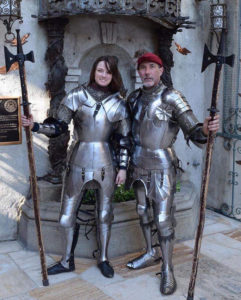
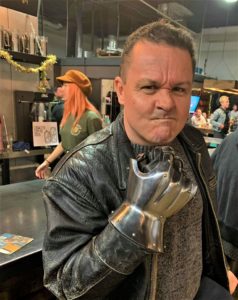
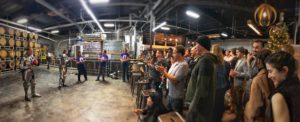
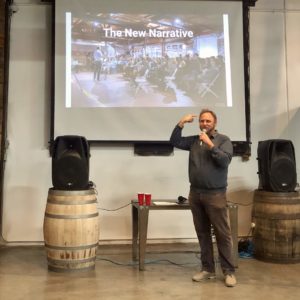
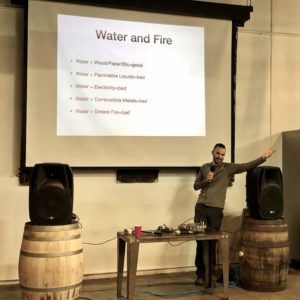
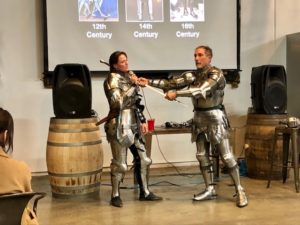
“There Goes the Neighborhood: A Short History of Nuclear Accidents”
Nuclear accidents have come in many shapes and forms, from dire to farcical, and have left indelible marks on science and society. Whether Chernobyl, the Radium Girls, or a clueless Boy Scout, find out why science goes wrong, and what happens when it does!
Anthony Neuberger has a degree in Nuclear Engineering from the University of New Mexico, where he studied fission reactor design and did research at Sandia National Laboratories. He currently works with Prompt Gamma Neutron Activation Analysis. When he is not working, he spends as much time diving as possible, because water is better at stopping neutrons than air.
“I HAVE THE POWER … in foreign policy making!”
We nerds are oh so good and leaving the P-word at the door, but this month we’re taking Politics face-on … under the guidance of a professional, of course. Dr. Fletcher received her PhD from SUNY with a dissertation titled “Overseeing Politics, Authority, and Unilateral Presidential Power [and so on. Frankly, she had us at ‘overseeing’. And again at ‘unilateral’. And again….]”. She teaches at SDSU, examining the institutional aspects of law through developmental and historical lenses to help understand law as a political phenomenon. By reconceptualizing judges as legal actors institutionally bounded and historically contextualized she lends a new perspective on how legal regimes do not map political regimes, how legal time intersects with political time, and the dynamic relationship that exists between law and power. Dr. Fletcher is particularly interested in the way the mutual construction process constrains legal decision-making and how law defines and redefines the constitutional order with-in which the executive makes decisions in foreign affairs.
What does this mean for YOU? She’s going to use He-Man to make her case for the Executive having the ultimate power in foreign affairs.
And finally, BEEEEEEEEEEEEEEEEEES!
(You asked for more on bees. You got it).
We closed the year with a show to remember!
1. THE SCIENCE OF SWEARING
Nearly everyone swears—in pain, anger, joy, or most relevantly, inebriation. Cognitive scientists have begun to look under the hood of profanity and the results are remarkable. How can stroke patients who are left otherwise speechless still swear fluently? Why do words like “zounds” or, more recently, “sucks” that were once taboo eventually lose their sting? What is it about Tourette Syndrome that can lead to the uncontrollable production of taboo words? In this talk, Dr. Ben Bergen showed how the cognitive science of profanity opens a new window onto how our brains process language. Also, there was a lot of swearing.
Dr. Bergen is a professor of Cognitive Science at UCSD. He wrote the book “What the F: What Swearing Reveals About Our Language, Our Brains, and Ourselves” … but don’t think less of him for it.
2. THE PRACTICE OF BEING COMFORTABLE WITH THE UNCOMFORTABLE
Every one of us is uncomfortable with something. What if you addressed what makes you uncomfortable, head on? On a consistent basis? This was a story of what happened.
San Diegan born and raised, Beck Bamberger graduated from UCLA in two years, then became the University of Pittsburgh’s youngest MBA graduate at 21. Beck started BAM Communications, a full service tech PR firm, while working as a TV host in San Diego. After winning an Emmy in 2011 for her TV work, she focused entirely on her entrepreneurial interests, growing BAM while starting Bite (San Diego’s top-rated and largest food tour company).
3. NO MICS: THE ANATOMY AND PHYSIOLOGY OF OPERATIC SINGING
How do opera singers produce those incredible sounds? Why can’t pop singers keep up? Do you have to be rotund to be a great performer? As a year-end treat, two local opera singers explained and demonstrated their skills. Bravi!
Alvin Almazan is a tenor with San Diego Opera’s Opera Exposed young artist and education outreach program, and has also performed as a soloist and chorister. His most recent roles have been in La Traviata with Capitol Opera, La Boheme with Capitol Opera, Amahl and the Night Visitors, Lilith (premiering the role in its staged form) at the IDEAS Workshop at UCSD, and Queen of Carthage, an adaptation of Purcell’s Dido and Aeneas with San Diego City Opera. Caitlin Tuttle is a charming operatic soprano, and Alvin’s voice coach.
1. LANDING ON THE MOON: HOW HARD IS IT, REALLY?
In the 1960’s, two superpowers were engaged in a titanic battle to land the first human on the moon. Why did America get there first? Why was Neil Armstrong chosen to make that first step? In this talk, SPACE HISTORIAN Francis French took you through the colorful personalities and risky decisions that led up to the historic moment of the first moon landing. Together we all toasted Dick Gordon: Apollo 12 astronaut, friend of Francis, and handsome bastard.
Mr. French is a Fellow of the British Interplanetary Society, and is the Educational Director of the San Diego Air and Space Museum. He’s authored a number of books and articles for Spaceflight Magazine, and he has even completed training at the US Space Academy whaaaaaaaaaaat!?
2. WHY ARE THERE STILL MONKEYS? AND OTHER STUPID CREATIONIST QUESTIONS
We looked at the pseudoscience of Creationism, and turned the willfully ignorant into the hilariously mocked. The evidence against Creationism via genetics, geology, the fossil record … the very universe itself, is overwhelming. Why don’t they get it??
Voted last year’s FAVORITE SPEAKER, PALEONTOLOGIST Trevor Valle returns to Nerd Nite San Diego once more! Trevor once got into a prolonged, intense Twitter war with Ke$ha and her fans, after he saw a photo of her defiling a fossil he spent years cleaning. He’s also the host of National Geographic’s “Mammoths Unearthed”, and he loves hockey more than you probably love anything.
1. Scott Farrell, Director and Head Instructor at San Diego’s Swords of Chivalry historical fencing program, part of the Chivalry Today Educational Program. He is co-author of the books “Martial Arts and Philosophy,” and “Batman, Superman and Philosophy,” and his articles on the ideals of chivalry have appeared in print and online publications all over the world – including the New York Times and the Shakespeare Birthplace Trust Blog!
Nerd Knight – Medieval Sword Fighting and The Philosophy of Chivalry
In this presentation, Scott introduced the growing field of Historical European Martial Arts (HEMA), talked about what Game of Thrones gets right (a little bit) and wrong (a whole lot!) when it comes to scenes involving sword fighting, and explored how the ideals of chivalry can be discovered by attacking your friends with lethal weapons.
2. Although she occasionally wears heels to work, Cathy Chang has learned to embrace the lab coat, gloves, and mask that mark her as a Forensic Biology Criminalist at the Crime Lab. In addition to her duties in the Biology Unit, Cathy spends her free time at crime scenes, because, well, that’s also part of her job. With twelve years of experience at the Lab, there’s a lot yet left to learn. But Cathy’s happy to share what she knows, especially if beer is involved.
The County Crime Lab’s Contribution to the World of Nerdly Things
Is Forensic Science really performed in minutes by analysts who wear designer clothing under sexy blue lighting? This talk familiarized you with your County Crime Lab. You learned how things like lasers, lines, and right triangles help solve crimes. And we even solved the mystery of what that blue light really does.
3. The Battle of Cannabis and Science
Sam David is the founder of Coastal Analytical, a lab responsible for cannabis analysis. A chemist and materials scientist, Sam is a member of the International Association of Analytical Chemists, and is certified as a quality manager by the American Society for Quality.
Sam shared the hurdles laboratories face when working with schedule 1 substances, including the difficulty of procurement as well as the stigma using marijuana for medical treatment.
Confront your biases and indulge your curiosity.
After a hiatus in July for Nerd Nite Speed Dating and the National Geographic/Nerd Nite/Comic Con party, Nerd Nite San Diego #11 was back to our regular awesomeness at 32 North Brewing in Mira Mesa! As a special welcome-back, schmancy donuts were courtesy of the most generous badasses at Devil’s Dozen Donut Shop (and the San Diego Boss, thanks to her shameless solicitation of gifts from strangers). Beach-n-Bowls food truck was also there, offering local tastiness for those who wanted “real food” and not “just donuts and beer for dinner”.
Dr. William Nericcio brought us The Trials and Tribulations of a Humble (Strange!?) English Professor: Tex[t]-Mex, Mextasy, Eyegiene, and Technosexualities in Paris, Rome, and Beyond
Notorious Mexican-American literature professor, public intellectual, artist, and troublemaker, William Nericcio was born in the fabled “Streets of Laredo,” (or at Mercy Hospital, at any rate). For years he labored under the watchful (sinister?), eyes of siblings and priests at Catholic schools – contributing to internet rumors that he was “raised by nuns”. With an PhD in Comparative Literature from Cornell University, Nericcio now works as the Director of the Master of Arts in Liberal Arts and Sciences, and is Professor of English and Comparative Literature at San Diego State University.
Tuesday evening we learned about his last decade as a Professor of English and Cultural Studies, beginning with the circumstances surrounding his award-winning book Tex[t]-Mex: Seductive Hallucinations of the “Mexican” in America, followed by his traveling exhibition (and would-be TV pilot) Mextasy. We’ll end with a peek at his new work Eyegiene: Permutations of Subjectivity in the Televisual Age of Sex and Race, and his latest project Robotic Erotic Electric: Techosexual Metamorphoses in the 21st Century.
Alien Education: Keep Your Filthy Paws Off My Uranium
In this talk, we learned the seldom-told tale of the Futures Panel. Advised by the most awesome Dr. Frank Drake (Astrophysicist; Pioneer of SETI, Project Ozma, Voyager Satelite Program, and Extraterrestrial Communications; Member of the Futures Panel), Dr. Ed Strong brought us the story of a small group tasked by Congress to solve a life and death problem: the waste from America’s growing nuclear stockpiles cannot be simply buried and forgotten. Can humans solve the “Forever Problem” by designing a communications system effective across language, culture, intelligence … and all of time to come? And if we do, will the “aliens” listen?
Edward Strong has a Doctorate in Genetics and Genomics. He lives in San Diego while doing his level best to avoid the research lab he was trained to work in. Together with his startup partners, Edward is developing a consumer-focused genetic information service. He also works to help other businesses understand development opportunities associated with recreational genetic testing.
Nothing Butt Time (The Boss gets to name all untitled talks, according to her favorite phrases in the description. Future speakers be warned).
The night’s final talk may have inspired us all to trade in our chairs for dorky standing workstations: Dr. Jacqueline Kerr, Associate Professor of Family Medicine and Public Health at UCSD, showed us how to measure butt time, how to gtfo of our chairs, and why we’ll all feel much better for it.
July our regular event was suspended in lieu of two special events: Nerd Nite-Nat Geo-ComicCon and Nerd Nite Speed Dating!
For the 4th year in a row, NatGeo teamed up with Nerd Nite for a FREE special SDCC edition. This Nite took the audience on an intergalactic journey through Earth and to Mars to celebrate the space exploration. Mars vs. Earth – a classic battle! Saturday July 22, 2017 from 7-11pm at the rooftop terrace and pool at Hotel Solamar at 435 Sixth Avenue in the Gaslamp District. The Nite featured three funny-yet-smart presentations by JPL’s Bobak Ferdowsi (‘The Mohawk Guy’) and Mallory Lefland, former NASA astronaut Jerry M. Linenger, and Aaron Sagers (Editor-at-Large of Blastr.com). FREE FOOD and DRINKS!
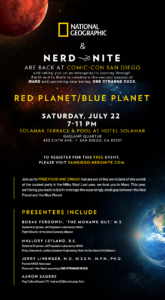
The first-ever Nerd Nite Speed Dating event in San Diego was held at Nate’s Garden Grill near City Farmer’s Nursery. Tickets included a drink or a biscuit sundae *drool* and ten dates with eligible nerds looking for friendship and companionship. A few people got cold feet, but everyone who participated met someone interesting. We’ll be doing this again in the future!
“The Lighter Side of San Diego’s Past”
San Miguel, or as we know it, San Diego, was once the end of the earth to European explorers. Today, everyone wants to live here. June’s second presentation highlights many of the little-known facts about our region and how we went from a sleepy outpost pueblo … to the eighth-biggest city in the United States.
Matthew Schiff is the Marketing Director for the San Diego History Center, and author of an autobiography on Douglas Pardee (of Pardee Homes) as well as several articles for The Journal of San Diego History. He decided to wear horizontal stripes to his talk because fuck it! He’s engaged now and it no longer matters.
“CRISPR the Disrupter: A New Era in Biology”
We are in the midst of a revolution in molecular biology thanks to CRISPR technology. In just a few short years, a repurposed bacterial immunity system is rapidly becoming a standard laboratory tool. Scientists are using CRISPR across a wide variety of disciplines from medicine and agriculture to biofuels and industrial food production. This talk explored a little about what CRISPR is and where it came from, and a little about the applications and challenges moving forward. It is an exciting time to be a molecular biologist!
Nick Brideau has a PhD in genetics and studied fruit fly speciation as a graduate student. He then moved across the Atlantic to drink British ale (and study epigenetics) before recently landing in San Diego. He currently works at the Salk Institute and is focused on finding and developing new CRISPR systems.
“Fission! What is it Good for? Absolutely Something!”
Approximately 20% of America’s electricity comes from nuclear fission; however, most Americans are unaware of how nuclear power works, or even what a nuclear reactor looks like! How *do* nuclear reactors work, and what makes a “good” reactor?
Popular alumnerd Anthony Neuberger examined the future of nuclear fission for our planet.
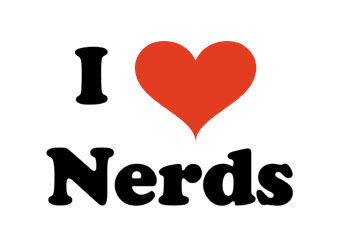
Looking for your intellectual significant other? Tinder isn’t offering you a content-based approach? Nerd Nite speed dating is a rare and special event, like ball lightning!
Here’s the deal: $15 gets you a drink (or a bisciut sundae, if you take more after my own heart), and more three-minute dates than most of us have been on in our lives, all in one compact evening. If you’re the introverted type, don’t fret: I’ve made helpful and relevant slides to grease your conversations.
Suggestion: bring an item that relates to you (origami bow-tie; picture of your cat; favorite book; Luke Skywalker action figure; homemade treat.
This particular event will be hetero-normative (sorry), until other interests are expressed.
*** Tickets will be up soon; much like a Kickstarter submission, we need a certain amount of interest for this event to take place. If enough tickets for BOTH sexes do not sell, your tickets will be refunded. ***













